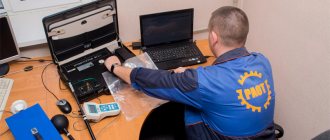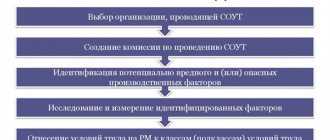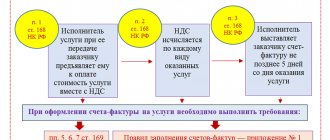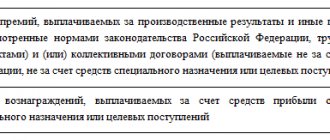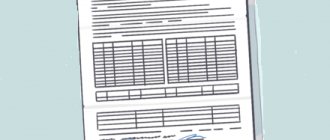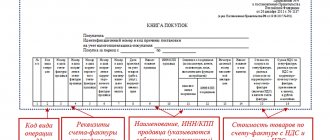27-1: work in difficult conditions
This is the first code of professions that belong to the list of those that involve work in difficult conditions. Encrypted under number 27-1:
- Underground works. They are occupied by people extracting minerals, builders of underground structures, and emergency rescue specialists. The exception is employees whose activities are related to the operation of the metro.
- Work in hot shops. All technologists working in such production are exposed to intense heat. Their health is also affected by the fumes released during the heat treatment process.
- Working in hazardous conditions. This includes activities, the implementation of which leads to negative changes in the body (the appearance of chronic and passing diseases, loss or decrease in performance). This is typical for specialists in the mining, oil, chemical and coal industries, electric power workers, metallurgical and abrasive workers, exploration geologists, microbiologists, radio and electrical engineers, as well as manufacturers of thermometers and hydrometers.
All citizens involved in any of the areas listed above begin to receive insurance pension payments ahead of schedule.
What codes to put in SZV-STAZH
In 2021, employers report to the Pension Fund on the personalized data of their employees using an updated form. No significant changes were made to the report, but some innovations, incl. in order of completion, yes.
All codes necessary for filling out the SZV-STAZH are deciphered in Resolution 507p dated December 6, 2018 in the appendix to the Procedure for filling out the “Parameters Classifier”. When submitting a report by deadline, employers must enter information in the first three sections, and if the basis for submitting the form is the employee’s retirement, then information will need to be reflected in all blocks of the report.
Codes in the SZV-STAZH form are reflected in the following columns of the table from section 3:
- 8 – it is necessary to record information about the presence of specific territorial working conditions;
- 9 – characterizes non-standard conditions for carrying out labor activities, which are the basis for an individual to receive early pension payments;
- 10, 11 – here the codes in the SZV-STAZH report reveal the features of calculating the insurance period in certain time periods;
- 12, 13 – the possibility of early pension assignment is justified;
- 14 – code designations in this column can only be used when drawing up a document for an unemployed individual by the employment service.
27-2: special conditions
This code of professions includes activities that involve work under special conditions. And they, in turn, are determined by the following factors:
- Chemical. In particular, increased concentrations of carcinogens and allergens in the workplace.
- Biological. This includes working with poisons, toxins, drugs, and infected material.
- Physical. These factors include all types of radiation, as well as human exposure to noise, vibration, as well as geomagnetic and electromagnetic fields.
- Circumstances. These are overloads, monotonous movements, intense impact on vision and eyes, and the worker staying in the same position for a long time.
The list of these factors has been approved by the Ministry of Health; it is required to be taken into account when signing an employment contract with an employee.
If we talk about specific examples, code 27-2 is assigned to the following professions:
- Everything related to metal processing.
- Ice producers.
- Drillers, dredgers, equipment operators, crushers.
- Skin processors.
- Dough mixers.
- Salt miners.
- Workers of sea fishing vessels.
- Food raw material washers.
- Port stevedores.
This, of course, is not the entire list of professions, but only some examples. I would also like to note that not every person can be allowed to work under difficult and harmful working conditions. There are contraindications, and these include:
- Congenital malformations.
- Chronic skin diseases.
- Cataplexy or narcolepsy.
- CNS disorders.
- Alcohol or drug addiction.
- Glaucoma.
- Any, even minor, diseases of the cardiovascular system.
That is why all candidates undergo a full medical examination before employment.
How can employees protect their rights if compensation for harmful working conditions has been cancelled?
It is also not indicated for all positions in which work is not related to the right to early assignment of a labor pension
27(28).Please note that if the same position appears in the staffing table in different departments, and for one of such positions special working conditions are indicated from those listed in lines 1-2 of the table (i.e. for this position, the attribute of additional contributions should be set ), and for the other are not indicated, then you should highlight separate elements for these jobs in the “Positions” directory and indicate for them different signs of additional contributions.
Thus, to calculate additional contributions, it is only necessary to set the appropriate attribute for “harmful” positions.
Contribution rates do not need to be configured; they are filled in automatically in the “technological” information register “Contribution rates for those employed in jobs with early retirement”
Figure 6
When calculating insurance premiums using the document “Calculation of insurance premiums”, all employee income is recorded indicating the relationship to the assessment of additional contributions (with the exception of the document “Piece work order for work performed”, which itself registers its income for the purposes of calculating insurance premiums).
Figure 7
Insurance premiums are calculated taking into account the value of this characteristic. Additional contributions are placed in a separate column depending on their type.
Figure 8
Separate accounting of “harmful” and “heavy” additional contributions is associated with their separate payment (each type has its own BCC). The document “Calculations for insurance premiums” registers the payment of accrued additional contributions.
Figure 9
In accounting, accrued additional contributions are recorded in subaccounts 69.02.5 and 69.02.6
https://www.youtube.com/watch?v=ytpressru
Figure 10
In the document “Adjustment of accounting for personal income tax, insurance contributions and unified social tax” it is possible to indicate the ratio of income to taxation with additional contributions, as well as the amount of accrued additional contributions
Figure 11
Changes have also been made to analytical reporting. The report “Analysis of accrued taxes and contributions” implements an additional option “PFR, contributions for employees with early retirement” for the analysis of additional contributions
Figure 12
An additional section has been added to the “Insurance Contributions Accounting Card” report, shown for employees who have been accrued additional contributions
Figure 13
Changes to the regulated reporting of contributions will be made as the relevant regulations are published.
Please note:
- If the organization pays contributions to finance additional pension payments in the coal industry or flight crew members, i.e. in the settings for calculating insurance premiums, the flag “Uses the labor of those employed in mining operations for coal and shale extraction” or “Uses the labor of flight crew members” is set, and the corresponding flags are set in the job information, then these contributions will continue to be calculated regardless of the “new” additional contributions
Figure 14
- Additional insurance premiums are registered without dividing into UTII and non-UTII parts
Let us recall that the rates for compulsory social insurance against industrial accidents and occupational diseases are established by Federal Law dated December 22, 2005 No. 179-FZ and are annually “extended” by separate Federal Laws (for example, for 2012 by Federal Law dated November 30.
2011 No. 356-FZ). Law No. 179-FZ provides, in particular, for the payment of only 60% of the established tariffs in relation to accruals made to employees who are disabled people of groups I, II and III. However, according to the text of the law, this “benefit” applies only to “organizations of any organizational and legal forms”; accordingly, it does not apply to policyholders who are individual entrepreneurs.
https://www.youtube.com/watch?v=https:accounts.google.comServiceLogin
Now this injustice has been eliminated - Federal Law No. 228-FZ dated December 3, 2012, by which tariffs are “extended” for 2013, includes Article 2, allowing individual entrepreneurs to pay only 60% of the established tariffs in relation to accruals made to disabled employees Groups I, II and III.
In accordance with this change in version 2.5.59, when calculating insurance premiums for employees of an individual entrepreneur who are identified as disabled, the corresponding “benefit” will be applied.
Figure 15
In accordance with Part 2 of Art. 10 of the Federal Law of December 3, 2012 No. 216-FZ, the indexation of state benefits for citizens with children provided for in Article 4.2 of the Federal Law of May 19, 1995 No. 81-FZ was carried out, from January 1, 2013 by 5.5%.
Also in accordance with the Decree of the Government of the Russian Federation of October 12, 2010 No. 813 and Part 1 of Art. 1 of Law No. 216-FZ, the maximum amount of social benefits for funerals provided for by Federal Law No. 8-FZ of January 12, 1996 was indexed.
New benefits and restrictions are set automatically when upgrading to version 2.5.59.
Figure 16
Please note that since 2011, the maximum amount of benefits for child care up to one and a half years is not limited, and the maximum amount is limited to the earnings on the basis of which the benefits are calculated. No recalculation of such previously recorded benefits is required.
The maximum value of the base for calculating insurance premiums has been increased in accordance with Decree of the Government of the Russian Federation of December 10, 2012 No. 1276
Figure 17
In accordance with Federal Law dated December 3, 2012 No. 232-FZ, from January 1, 2013, the minimum wage (minimum wage) was established in the amount of 5,205 rubles. per month. Let us remind you that this value in the program is used exclusively for calculating benefits. If accruals with arbitrary formulas are used, in which your own minimum wage indicator appears (for example, “Additional payment to the minimum wage”), then the new value of the indicator, if necessary, should be entered independently.
- section XXXIII of List No. 2, approved by the Cabinet of Ministers of the USSR in Resolution No. 10 of January 26, 1991, according to which the length of service of workers in difficult conditions has been recorded since 1992;
- List No. 2, approved by the USSR Council of Ministers in Resolution No. 1173 of August 22, 1956, according to which the work experience of workers in difficult conditions was recorded until 1992.
- availability of official employment and regular payments to the Pension Fund;
- the name and code of the position must coincide with List No. 2 and be reflected in all official documents of the employee (work book, employment order, employment contract, as well as personal registration documents sent to the Pension Fund of the Russian Federation).
- at the workplace, during a special assessment or certification, a harmful or dangerous class of working conditions must be established;
- special experience (electrical and gas welder experience) should be 12.5 years for male workers and 10 years for female workers with a total experience of 25 (20) years, respectively (clause 2 of article 30 of Federal Law 400).
27-3: women's labor
Continuing to talk about special working conditions, it’s worth moving on to the next code. Number 27-3 is assigned to women's activities related to specific areas. This includes tractor drivers in agriculture and other economic sectors, as well as operators of loading and unloading, road and construction machines.
Work in such areas of activity is difficult for objective reasons. Moreover, she is characterized as masculine.
Take, for example, the profession of a tractor driver. While working, he is exposed to vibration and noise, and spends about 1/3 of his time in an extremely uncomfortable position.
He also needs to manage, repair, and maintain in working order different types of tractors, trucks and combines. In addition, the tractor driver plows and sows the land, removes rotten crops, transports successful crops, prepares food, clears snow, and digs trenches.
Of course, all this is special working conditions for men, but for women, everything listed earlier is placed in a separate category, designated by a personal code.
SZV-KORR
In the SZV-KORR adjustment report in 2021, codes for special working conditions are shown in column 4 of section 6:
SZV-ISH
As for the SZV-ISH report, the codes of special working conditions should be reflected in it according to column 5 of section 8:
27-4: textile industry
This is also how women’s work is designated, but only in the textile industry, in work with increased severity and intensity.
Specialists involved in this field are engaged in the processing of fibrous substances of synthetic, animal, vegetable and mineral fibers. This process consists of several operations. These are extraction, production, spinning, weaving, and finishing of fiber.
All this requires significant physical stress from workers. It is not surprising that an assessment of working conditions in textile production revealed that they are difficult. After all, the following factors influence employees:
- Increased air humidity and temperature.
- High frequency noise 94-105 dB.
- Air dustiness.
- Strong vibrations.
- Toxic substances that may come into contact when bleaching fabrics.
- The employee is in an upright position with frequent bending and moving.
- Visual intensity.
- Extreme concentration of attention.
Contributions at additional rates for employees with early retirement
One of the changes introduced by Federal Law No. 243-FZ1 dated December 3, 2012 is the introduction, from January 1, 2013, of additional insurance tariffs to finance the insurance part of the labor pension in relation to payments and other remuneration in favor of persons employed in the types of work specified in paragraphs. 1-18 paragraph 1 art. 27 of the Federal Law of December 17, 2001 No. 173-FZ.
The amount of the additional tariff depends on whether the work is classified as, relatively speaking, “harmful” (clause 1, clause 1, article 27 No. 173-FZ) or “heavy” (clauses 2-18, clause 1, article 27 No. 173-FZ). It is also envisaged that additional tariffs will increase in future years.
When calculating insurance premiums for these tariffs, there is no limitation on the base by a maximum value (in 2013 - 568,000 rubles).
Let us remind you that these persons have the right to early assignment of a labor pension and personalized accounting information for them is submitted with the appropriate notes regarding information about their length of service. To automatically generate such information in the program, it is (and was) possible to indicate the appropriate grounds in the staffing table or in information about the position.
However, these signs cannot be used when the program decides whether to accrue contributions at an additional rate to employees employed in such positions or staffing positions, since, in particular, the law provides for an exemption from the payment of such contributions “based on the results of a special assessment of the conditions labor."
In connection with these changes, in version 2.5.59 it is possible to indicate in the information about a position whether contributions at an additional rate should be charged to employees employed in it, and also to clarify which category (harmful or heavy) this position belongs to , since contribution rates vary for different conditions.
Picture 1
To enable this feature, you need to set the appropriate flag “Works with early retirement are used” in the form for setting up accounting parameters on the “Calculation of insurance premiums” tab.
Figure 2
| Code of length of service | Subclause 1 of Art. |
27-6: work in open areas
This code denotes the following works:
- Exquisite.
- Hydrological.
- Geophysical.
- Forest management.
- Hydrographic.
- Search engines.
- Geological exploration.
- Topographic and geodetic.
That is, all people who work in detachments, expeditions, brigades and sections belong to this category.
PFR service codes in the SZV-STAZH report
Table 3 presents codes that characterize the basis for calculating the insurance period in specific working conditions:
These ciphers fit into column 10, provided that column 9 is filled in.
Codes “Calculation of insurance period: basis”
| Code | Full name |
| SEASON | Work for a full navigation period on water transport, a full season at enterprises and organizations in seasonal industries |
| FIELD | Work in expeditions, parties, detachments, on sites and in teams during field work (geological exploration, search, topographic-geodetic, geophysical, hydrographic, hydrological, forest management and survey work) directly in the field |
| UIK104 | Work of convicts while they are serving a sentence of imprisonment |
| DIVER | Divers and other underwater workers |
27-7: rafting and logging
Above we talked about above-ground and underground work. Code 27-7 denotes “related” activities. To be more precise, work in timber rafting and logging. This also includes maintenance of equipment and machinery.
Here are some professions from this category as an example:
- Forest fellers.
- Winches on the skid.
- Riders.
- Crosscutters.
- Skidding machine operators.
- Lumberjacks.
- Wood sorters on the water.
- Crane operators.
- Drivers of a car hauling timber.
- Loaders.
- Branch cutters.
- Rafters.
- Equipment repair mechanics.
Error when generating the RSV-1 PFR report
IHello.
We encountered the same problem. UPP 1.3.66.2 (standard), we encountered the following problem: when generating the RSV-1 report on “pests” (beneficiaries), an error appears: “The list item code cannot be specified without specifying the special working conditions code.”
As we understand, for some reason code 27-2 of special working conditions is not included in the list. It is filled in organizational positions, as well as in the staffing table. The list position code is selected from the classifier.
In the “preparation of Pension Fund data” processing, this code is filled in in the “working conditions” column, but nevertheless produces a similar error.
Who has encountered this - how to deal with it? Where else should I include this code to fix this error?
TurboConf 5 - expanding the capabilities of the 1C Configurator
ATTENTION! If you have lost the message input window, press Ctrl-F5 or Ctrl-R or the Refresh button in your browser.
The topic has not been updated for a long time and has been marked as archived. Adding messages is not possible. But you can create a new thread and they will definitely answer you! Every hour there are more than 2000 people on the Magic Forum.
27-8 and 27-9: work in the port
These codes can be combined for a logical reason, because they include areas related to the port.
So, first we should talk about code 27-8. It denotes the area of loading and unloading port activities in which machine operators of complex teams are employed.
Code 27-9 defines a wider spectrum. To be more precise, work as a crew member on river, sea and fishing fleet vessels. The following ships are exceptions:
- Port workers who work in the port waters.
- Traveling.
- Service and auxiliary.
- Intracity and suburban communication.
What codes in SZV-STAZH indicate the presence of conditions for early assignment of a pension?
If an employee has grounds to claim early pension payments, the working conditions are detailed in columns 12 and 13. The breakdown of codes in SZV-STAZH for these positions is presented in Table 5:
Codes “Conditions for early assignment of an insurance pension: basis”
| Code | Full name |
| 27-11GR | Underground and open pit mining |
| 27-11VP | Leading professions in underground and open-pit mining |
| 27-12 | Work on vessels of the fishing industry fleet for the extraction, processing of fish and seafood, acceptance of finished products in the fishery (regardless of the nature of the work performed), as well as on certain types of vessels of the sea, river fleet and fishing industry |
| 27-SP | Working as a rescuer in professional emergency rescue services, professional emergency rescue teams and participation in emergency response |
| 27-PD | Pedagogical activities in schools and other institutions for children of all teaching staff in positions named in the List of September 6, 1991 No. 463 and List of September 22, 1999 No. 1067, including for directors (chiefs, heads) of orphanages, sanatorium orphanages and special (correctional) orphanages for children with developmental disabilities, and deputy directors (chiefs, managers) for educational, educational, educational, production, and other work related to the educational process, institutions specified in paragraphs 1 - 7, 9, 10 List dated September 22, 1999 No. 1067 |
| 27-PDRK | Pedagogical activities in schools and other institutions for children as directors (chiefs, heads) of institutions specified in paragraphs 1 - 3 (except for orphanages, sanatorium orphanages and special (correctional) orphanages for children with developmental disabilities, 4 - 7 , 9, 10 List of September 22, 1999 No. 1067 |
| 27-GD | Medical and other work to protect public health in cities |
| 27-SM | Medical and other work to protect public health in rural areas |
| 27-GDHR | Surgery-related medical work in cities |
| 27-SMHR | Surgery-related medical work in rural areas |
| CREATIVE15 | Creative work for at least 15 years |
| CREATIVE20 | Creative work for at least 20 years |
| CREATIVE25 | Creative work for at least 25 years |
| CREATIVE30 | Creative work for at least 30 years |
| AIRPLANE | Work as a flight crew on civil aviation aircraft |
| SPECAV | Work as a flight crew on helicopters, in special aviation |
| SPASAV | Work as part of an aircraft flight crew in emergency rescue (search and rescue) units |
| ACCOUNT | Work as flight personnel in educational and sports aviation organizations of DOSAAF, subject to the fulfillment of the flight training plan |
| VYSHSPIL | Work as flight personnel in educational and sports aviation organizations of DOSAAF when performing elements of aerobatics |
| NORMAPR | Parachutists who completed the annual quota of jumps from piston aircraft, and so on |
| NORMSP | Parachutists who have completed the annual norm of descents (ascents) from piston aircraft, and so on on special descents (ascents) devices |
| REACTIVE | Parachutists who have completed the annual quota of jumps from jets and helicopters |
| LETRAB | Parachutists, as well as aviation flight personnel in educational and sports aviation organizations of DOSAAF |
| LETISP | Flight test crew |
| ITSISP | Engineering and technical staff performing test flights |
| ITSMAV | Engineering and technical staff performing test flights on maneuverable aircraft and helicopters |
| INSPECTION | Workers inspecting flight crews on test flights |
| 27-14 | Air traffic control work |
| 27-15 | Work in the engineering and technical staff for aircraft maintenance |
27-10: chauffeur activity
This code designates the profession of drivers of trams, trolleybuses and buses. They are also workers with special working conditions. And there are many factors that determine the level of difficulty:
- Technical: type of transport, gross weight, technical condition, dynamic characteristics, dimensions, presence/absence of a trailer.
- Technological: route features, characteristics of the cargo, its dimensions, availability of special equipment.
- Organizational: passenger flow, stability, length and non-linearity of the route, frequency of stopping points, schedule.
- Social: the driver’s age, his length of service, work and rest schedule, qualifications, length of the working day, combination of duties.
- Road climatic: mountain or quarry conditions, nature and climate, condition and type of road surface.
- Ergonomic: level of vibration and noise, ease of location of control levers, dust, ventilation and temperature in the cabin, visibility and illumination, thermal radiation, air humidity, space.
- Economic: organization of work, features of its payment and distribution of salaries in the team, financial indicators of the enterprise.
- Organizational and technical: frequency of intersections, traffic intensity, permitted speed and road capacity.
And these are not all the factors taken into account when assessing working conditions. Of course, visually the actions performed by the driver are simple. But there are a lot of them, and all of them together create an incredible burden.
Codes in column 11 SZV-STAZH
Column 11 contains data reflecting the specifics of the periods included or excluded from the insurance period. The complete list of ciphers is presented in Table 4:
Codes “Calculation of insurance experience: additional information”
| Code | Full name |
| CHILDREN | Holiday to care for the child |
| DECREE | Maternity leave |
| AGREEMENT | Work under civil law contracts, including those beyond the reporting (calculation) period |
| DLOTPUT | Staying on paid leave (applied when employees with special working conditions do not have additional tariff contributions accrued) |
| VRNETRUD | Period of temporary incapacity for work |
| WATCH | Shift rest time |
| MONTH | Transfer of an employee from a job that gives the right to early assignment of an old-age pension to another job that does not give the right to the specified pension, in the same organization due to production needs for a period of no more than one month during a calendar year |
| QUALIFY | Off-the-job training |
| SOCIETY | Performance of state or public duties |
| SDKROV | Days for donating blood and its components and rest days provided in connection with this |
| SUSPENDED | Suspension from work (preclusion from work) through no fault of the employee |
| SIMPLE | Downtime caused by the employer |
| ACCEPTANCE | Additional leave for employees combining work and study |
| MEDNETRUD | The period of work corresponding to the transfer, in accordance with the medical report of a pregnant woman at her request, from a job that gives the right to early assignment of an old-age labor pension to a job that excludes the impact of unfavorable production factors, as well as the period when the pregnant woman did not work until the issue of her employment in accordance with the medical report |
| NEOPLDOG | The period of work of the insured person under a civil contract, payments and other rewards for which are accrued in the following reporting periods |
| NEOPLAUT | The period of work of the insured person under the author's contract, payments and other rewards for which are accrued in the following reporting periods |
| DOPVIKH | Additional days off for persons caring for disabled children |
| ZGDS | Information about a person holding a government position in a constituent entity of the Russian Federation on a permanent basis |
| DDG | Information about a person holding a government position in the Russian Federation |
| ZGGS | Information about a person holding a position in the state civil service of the Russian Federation |
| ZMS | Information about a person holding a municipal service position |
| PHI | Information about a person holding a municipal position on a permanent basis |
| Codes “Calculation of the insurance period: additional information (periods not included in the insurance period)” | |
| Code | Full name |
| DLCHILDREN | Child care leave up to 3 years |
| Chernobyl Nuclear Power Plant | Additional leave for citizens exposed to radiation as a result of the disaster at the Chernobyl nuclear power plant |
| NEOPL | Vacation without pay, downtime due to the fault of the employee, unpaid periods of suspension from work (preclusion from work), unpaid leave of up to one year provided to teaching staff, one additional day off per month without pay provided to women working in rural areas localities, unpaid time for participating in a strike and other unpaid periods, except for periods with codes DLDETI and Chernobyl NPP |
| CHILDREN | Parental leave until the age of three, granted to grandparents, other relatives or guardians actually caring for the child |
Examples of using such codes:
- The code “DLOTPUSK” in SZV-STAZH, starting with reporting for 2021, is used only to highlight time intervals when a person, while working, was exposed to negative external factors (work in harmful, difficult and similar conditions), but insurance contributions There were no additional contribution rates.
- The “AGREEMENT” code in SZV-STAZH can be used by employers for individuals hired to perform work under civil law contracts concluded with them. But this letter combination will be reflected in the report only if such a citizen received remuneration from the employer in the reporting period under review. If there were no cash payments, the code “NEOPLDOG” is used; data on persons receiving royalties is also shown separately - “NEOPLAVT”.
- The “CHILDREN” code in SZV-STAZH is used to display information about periods when the employee did not perform labor functions due to being on parental leave (up to 1.5 years). If an employee or employee, after the child reaches the age of 1.5 years, decides not to go to work, but continues to look after the child until the age of three, the code “DLCHILDREN” in SZV-STAZH will reflect the period of such leave.
- The letter combination “VRNETRUD” is a sick leave code in SZV-STAZH, used by employers without reference to the reasons for temporary disability.
- The “NEOPL” code in SZV-STAZH is intended to allocate employee vacation time without maintaining the average salary, downtime due to the employee’s fault, and in other cases.
27-ПЗ: fire service
This code is assigned to positions related to the fire service. Here are just a few professions taken from the list:
- Fire truck driver.
- Spotlighter.
- Boatswain of a fire ship.
- Operational detachment duty officer.
- Communications dispatchers working in the Ministry of Emergency Situations of Russia.
- Fire engineers.
- Prevention instructors.
- Fire department and department commanders.
- Gas and smoke protection service specialists.
- Chiefs of the detachment, guard, fire trains, mobile pumping stations.
Of course, the list is incomplete. And you don’t even need to clarify why the working conditions in the fire service are special. People come into contact with uncontrollable elements that destroy everything around them - they are always in danger.
How can employees protect their rights if compensation for harmful working conditions has been cancelled?
It is also not indicated for all positions in which work is not related to the right to early assignment of a labor pension
- Contact the HR department at your place of work and find out whether your company conducts a special assessment of working conditions and whether its results are documented in the manner prescribed by Law No. 426 of December 28, 2013. Since a special assessment of working conditions is a new phenomenon, it is quite possible that it has not yet been carried out at your enterprise. In this case, it is necessary to find out whether the employer has documents on certification of workplaces, which was mandatory before the adoption of Law No. 426.
- If all the documents are in order, the next question that needs to be clarified is whether information about you as a beneficiary is submitted to the Pension Fund, and whether the necessary codes are indicated in the documents.
- If the information is not submitted (has not been submitted), you should not despair. Early retirement can be granted without them. However, in this case, you need to contact the Pension Fund in advance, since it will take some time to obtain documentary evidence of your experience.
- Upon reaching the required total length of service, you need to contact the Pension Fund of the Russian Federation with your passport, pension certificate and work book to determine your right to early retirement.
- If the conditions of clause 2 of Article 30 of Federal Law No. 400 are fully met, you will be asked to write an application for early retirement. If you have all the necessary documents, the pension will be assigned to you from the day you write the application, but not before you have the right to it.
Assignment and registration of a preferential pension based on harmfulness
The type of pension provision, regardless of whether we are talking about social, funded or insurance we are interested in, in our country is purely applicant-based. Don't expect someone to bring you something on a silver platter. You need to independently take certain steps to collect documents and submit them to the branch of the Pension Fund of the Russian Federation, where the registration will be carried out, as well as the accrual and payment of the pension ahead of schedule.
We count ourselves
The correct calculation of a preferential pension according to List 2 is not difficult, since a special formula is used for this, which greatly simplifies the calculations:
SPst = IPK × SPK + FV
Let's break down the abbreviations:
SPst is the full amount of the old-age insurance pension due to a person.
IPC – pension points or coefficients calculated individually.
SPK is the cost of one coefficient at the moment when a person decided to retire early.
FV – fixed payment.
The penultimate indicator is a fixed amount, from which PF specialists will “dance”. It is determined by the government, but can be indexed and updated. For 2021, this figure is set at 78.28 rubles.
At the same time, you should know that for the same year the required number of IPCs has been established - 11.4 units. Moreover, it will increase with each accounting period (year), until in 2024 it reaches exactly 30 units. The fixed payment at this time is 4805.11 rubles. Using simple mathematical calculations, you can easily determine “roughly” what amount to expect.
An example of calculating a pension on the 2nd grid
Alexey Ivanovich Almazov is 54 years old. The total length of service is 26 years, 13 of which were worked in hazardous industrial production for 4 years according to list 1 and 9 years according to list 2. Taking into account the Labor Code of the Russian Federation, citizen Almazov can become a pensioner at the age of 57 according to list 2. However, if you take into account immediately profession on both lists with 13 years of experience, then Almazov will become a pensioner at 55 years old.
List of documents
- An application for an early pension, a sample form of which can be easily downloaded from our website.
- Passport of a citizen of the Russian Federation or any other document that can prove identity.
- All documents and certificates that confirm the right to early retirement. These could be extracts from employment records, contracts, accounting cards, etc.
- Military ID for men (if available).
- Education documents, birth certificates of children and other papers that pension fund specialists may require.
If something is missing, then it is permissible to submit the certificates within one month after the initial submission of the application.
Registration procedure
Having collected all the necessary papers, they need to be provided to PF specialists so that they can process, accrue and pay an early pension. This can be done in a variety of ways:
- By sending all certificates and copies by mail. Remember that the letter must be recommended, as well as with a list of attachments.
- Register a personal account on the regional website of the Pension Fund of the Russian Federation and upload scans of papers to the server.
- Use the services of MFC specialists.
- Take all documents personally and hand them over to the fund inspector.
The latter method will require spending more effort, time and nerves, since the corridors of the pension fund are usually full of people, but there are also special advantages. For example, this way you can immediately find out which certificates are missing and correct existing errors. Within ten days, specialists must answer how, what and when you will receive.
What do absence codes reflect?
What is the composition of the codes included in the tables intended for column 11? The periods taken into account in the length of service include, for example:
- leave (regular, educational, to care for a child up to one and a half years old, without pay within the duration determined by the Labor Code of the Russian Federation);
- sick leave (including those issued in connection with pregnancy and childbirth);
- periods when work is impossible due to production technology or reasons beyond the control of the employee;
- periods of work under GPC agreements.
With regard to the latter periods, it should be noted that they may have different codes depending on whether payment was made for work performed under the contract.
Among those not taken into account in the length of service are, for example, maternity leave for up to three years and without pay beyond the duration determined by the Labor Code of the Russian Federation, as well as other unpaid periods.


